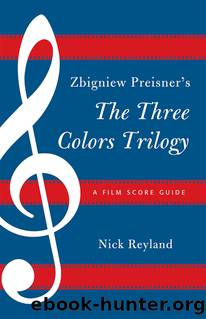Zbigniew Preisner's Three Colors Trilogy: Blue, White, Red by Reyland Nicholas W.;

Author:Reyland, Nicholas W.;
Language: eng
Format: epub
ISBN: 1392782
Publisher: Scarecrow Press, Incorporated
Bliss
Responding to a scene in Véronique where Weronikaâs double comes to rest in a sliver of sunlight, Kickasola suggests that â[m]oments like these are critical in KieÅlowskiâs films because they function without words but exude an extraordinary phenomenological impact: we feel the warmth and sympathize with her inner state and need for respite.â118 The KieÅlowski music-films, as noted already in the present analysis, contain pivotal moments in which Preisnerâs music or the sound design are deployed to push audio-viewers into the experiential realm. In Blue, many of these moments are startling shocks. When Julie, echoing the scene in Véronique, experiences a moment of blissed-out plenitude as she listens to the busker while basking in a sunny park, the phenomenological counterbalancing of Blueâs more anguished moments entices one to relax with her and enjoy this brief but telling liberation.
In addition to the sunshine, Julie basks in musical warmth. The moment of bliss occurs as, ostensibly, she listens to the busker. The sceneâs representation of the mesmerizing effect of music on Julie as she begins to âflowâ evokes a statement by Henri Bergson: âA melody to which we listen with our eyes closed, heeding it alone, comes very close to coinciding with this time which is the very fluidity of our inner life.â119 In turn, this may remind one of KieÅlowski: âItâs a saying as old as the worldâfreedom lies within. Itâs true.â120 If Julie has been healing internally through her repetitively rhythmic regime of simple pleasuresâcoffee and ice cream, swimming (another kind of âflowâ), listeningâthen her moment in the sun marks the pinnacle of the restorative period of her grieving; as her doctor tells her in a nearby scene, she is clearly in good âspirits.â But is she only listening to this music?
Most critical responses to this scene fixate on the old lady and the bottle bank, reading Julieâs ignorance of that struggleâa recurring motif in all three films, each time eliciting a revealing response from the central protagonistâas a sign of self-absorption.121 In what, however, is Julie so immersed that she does not notice the struggling old lady? One could argue the case that she is not listening to the busker but composing the music one hears, and that she is enraptured by her own musical thoughts. Any creative musician knows this kind of âflowâ: oneâs mind and inner ear become so engaged with âhearingâ a new musical idea that one fails to hear what someone real is saying. The busker is not seen during this scene: one only hears what one at first assumes to be his diegetic music-making. He could indeed be âpresent,â outside of the frame. Yet given musicâs âside-by-sideâ liberty in the film, Julie could also be imaginingâand thus composingâthe music that she hears. If she is creating the music, this scene is an indication of the role that making music will play in her final phase of grief-work: re-engaging with the traces, musical and otherwise, of her loss.122
The screenplay is revealing here. Julie is in a trance, it says, and does not notice the old lady.
Download
This site does not store any files on its server. We only index and link to content provided by other sites. Please contact the content providers to delete copyright contents if any and email us, we'll remove relevant links or contents immediately.
Naked as Nature Intended by Pamela Green(415)
The Filmmaker's Guide to Creatively Embracing Limitations: Not Getting What You Want Leading to Creating What You Need (for True Epub) by Pace William & Stobbe Ingrid(412)
30 Movies to Get You Through the Holidays by Roger Ebert(388)
Bond, James Bond by Brad Gilmore(351)
It's Only a Movie! by Haberski Jr. Raymond J(320)
Chinese films in focus II by Unknown(280)
How To Write A Novel The Easy Way Using The Pulp Fiction Method To Write Better Novels: Writing Skills by Jim Driver(266)
Smartphone Cinema: Making Great Films with Your Mobile Phone by Bart Weiss(265)
The Fellowship of the Knits: Lord of the Rings: The Unofficial Knitting Book by Tanis Gray(264)
Film Truth; November, 1920 by Anonymous(259)
Charles McGraw by Alan K. Rode(255)
The Greatest Show on Earth by Jerry Pinto(253)
Jafar Panahi: Interviews by Unknown(230)
Thomas Mann and Friedrich Nietzsche: Eroticism, Death, Music, and Laughter by Caroline Joan Picart(230)
The Garden in the Machine by Unknown(229)
The Reel Truth by Reed Martin(229)
Jurassic Park and Philosophy by Watkins Jessica Michaud Nicolas(224)
The Japanese Cinema Book by Hideaki Fujiki & Alastair Phillips(219)
Euro-Visions: Europe in Contemporary Cinema by Mariana Liz(215)
